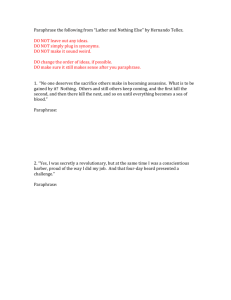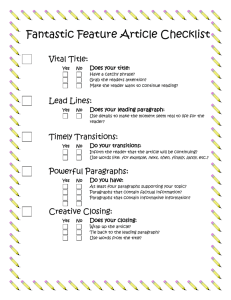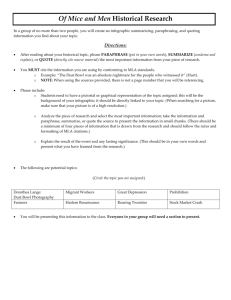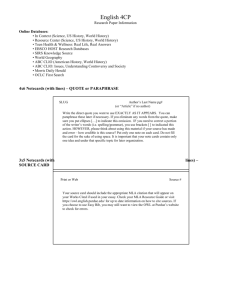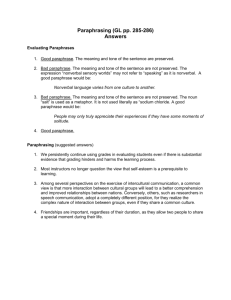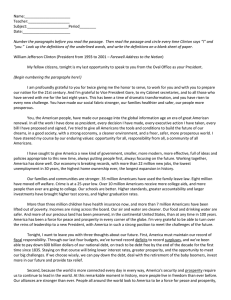Using MLA style for taking notes
advertisement
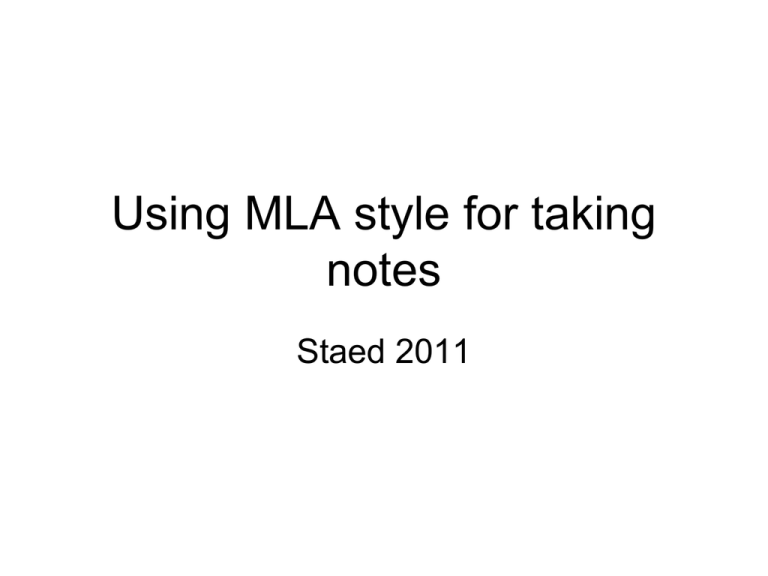
Using MLA style for taking notes Staed 2011 Avoid Plagiarism • Include all necessary source info in order to avoid “borrowing” unlawfully Show your great sources • Let your reader know that you have read the experts and they have informed your view Do not overuse direct quotes • Paraphrase for most of the info to show that you understand it, but ALL INFO THAT IS NOT YOUR ORIGINAL IDEA MUST BE ATTRIBUTED TO A SOURCE MLA notes • Top Frame: Introductory phrase that identifies the author or the source • Window: quote or paraphrase or summary • Bottom Frame: Location of material Example notes • As humorist Mike McGrady once said about housekeeping, “Any job that requires six hours to do and can be undone in six minutes by one small child and carrying a plate of crackers and a Monopoly set--this is not a job that will long capture my interest”(13). Identify the info by whatever is listed first on the bib or works cited • Each year 350,000 Americans will die of a heart attack before reaching the hospital (“First Aid for Heart Attacks” 88). If the material you use is quoted from another source • According to George Orwell, “Good writing is like a window-pane”(qtd in Murray142). Take no more than 2-3 notes/source • You do not want to count on one source for all of your info--show that there are many professionals that have chimed in on your topic Keep track! • Do not make yourself do it twice--do it right the first time. Consider where you want to use the info as you take the note—if you don’t know how you want to use, think before you take the time to paraphrase or summarize it! Consider this paradigm for organization of notes I. Hook Reader with startling info (1-2 paragraphs) II. Establish problem and state thesis(23 paragraphs) III. Explore solutions and offer support for best solution (3-4 paragraphs) IV. Finalize discussion and bring reader to overall understanding, maybe a call to action (2-3) See if you can answer these questions. 1. What does (sic) mean when used with a direct quote? Example--According to John Small, in his essay, "Why Krispy Kremes Taste Better the Next Morning" the most important idea to keep in mind is that "the grease is better than the kreme (sic) the next day" (5). 2. A good research paper should consist of many direct quotes with very little analysis from the writer. (True or False) 3. Paraphrased ideas need to be attributed to an author because they are borrowed ideas. (True or false) 4. When you summarize material from an outside source you don't need to attribute those ideas to an author. (True or False) The following paragraph contains several sentences that appear as paraphrase but are not paraphrased well. Examine the language and tone of each sentence, as well as the continuity of the paragraph. See if you can find the two sentences that should be reworked. The Beatles’ music in the early years was just plain melodic. It had a nice beat to it. The Beatles were simple lads, writing simple songs that were simple to play to screaming fans on one-night stands (Johnson 23). There was no deep, inner meaning to their lyrics. Their songs included many words like I, and me and you. As the years went by, the Beatles’ music became more poetic. Sergeant Pepper is a stupefying collage of music, words, background noises, cryptic utterances, orchestral effects, hallucinogenic bells, farmyard sounds, dream sequences, social observations, and apocalyptic vision, all masterfully blended together on a four-track tape machine over nine agonizing and expensive months (Jones 25). Take your time • It is worth it to take notes carefully and thoughtfully—as if you are writing the paper as you take notes. • Good luck!

